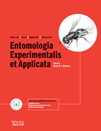Ver ítem
- xmlui.general.dspace_homeCentros Regionales y EEAsCentro Regional Patagonia NorteEEA BarilocheArtículos científicosxmlui.ArtifactBrowser.ItemViewer.trail
- Inicio
- Centros Regionales y EEAs
- Centro Regional Patagonia Norte
- EEA Bariloche
- Artículos científicos
- Ver ítem
Spatial dynamics of a Sirex noctilio woodwasp population within a pine plantation in Patagonia, Argentina
Resumen
The woodwasp Sirex noctilio F. (Hymenoptera: Siricidae) is probably the most important pest of pine tree plantations of the southern hemisphere. We studied the spatial arrangement of an endemic population of the woodwasp S. noctilio within pine plantations located in northwest Patagonia, Argentina, during three successive years since colonization. By censusing healthy and attacked trees, which provided data on current and past yearly woodwasp attacks, we
[ver mas...]
The woodwasp Sirex noctilio F. (Hymenoptera: Siricidae) is probably the most important pest of pine tree plantations of the southern hemisphere. We studied the spatial arrangement of an endemic population of the woodwasp S. noctilio within pine plantations located in northwest Patagonia, Argentina, during three successive years since colonization. By censusing healthy and attacked trees, which provided data on current and past yearly woodwasp attacks, we studied: (i) the spatial pattern of attacked trees during the endemic phase of a woodwasp population, and (ii) the changes in the spatial arrangement through time and with an increasing (i.e., no intervention) pest population. Among a total of 53 649 counted trees, attack rates were low during the study period (accumulated attack below 0.5%). Results of spatial statistical analysis showed that woodwasp attack is highly clumped, and that spatial aggregation increases with time, even with increasing numbers of attacked trees. The observed spatial arrangement, a consequence of a demographic process, can have important implications for the management of woodwasp populations and contributes to our understanding of the nature of outbreak population behaviour in this pestiferous forest insect.
[Cerrar]

Fuente
Entomologia Experimentalis et Applicata 125 (3) : 231-236 (December 2007)
Fecha
2007-12
Editorial
Wiley
ISSN
0013-8703
1570-7458
1570-7458
Formato
pdf
Tipo de documento
artículo
Palabras Claves
Derechos de acceso
Restringido
 Excepto donde se diga explicitamente, este item se publica bajo la siguiente descripción: Creative Commons Attribution-NonCommercial-ShareAlike 2.5 Unported (CC BY-NC-SA 2.5)
Excepto donde se diga explicitamente, este item se publica bajo la siguiente descripción: Creative Commons Attribution-NonCommercial-ShareAlike 2.5 Unported (CC BY-NC-SA 2.5)

